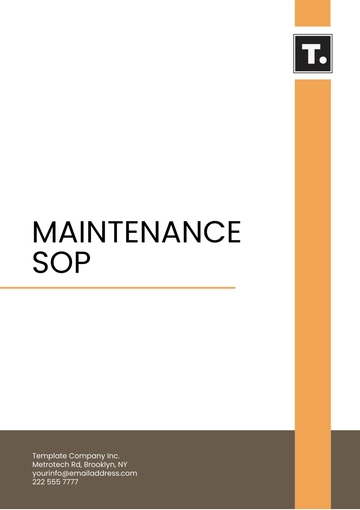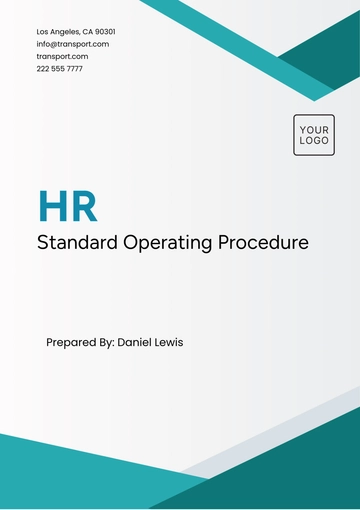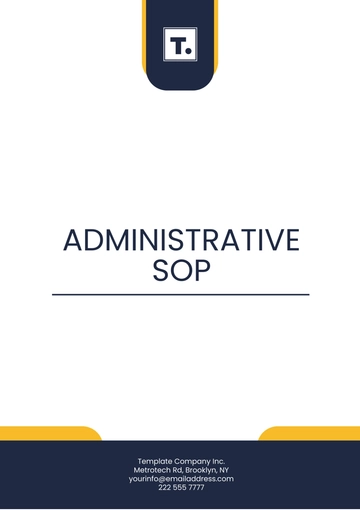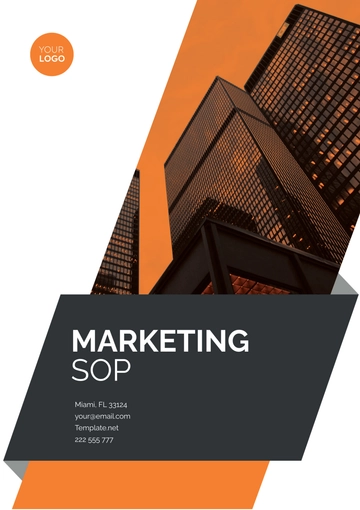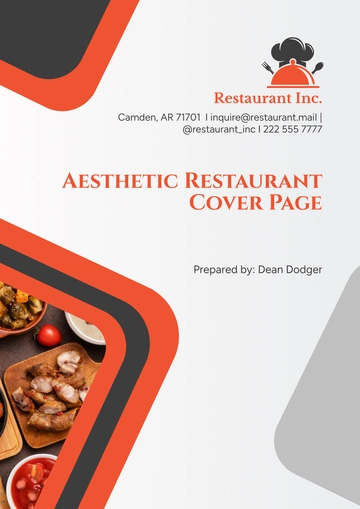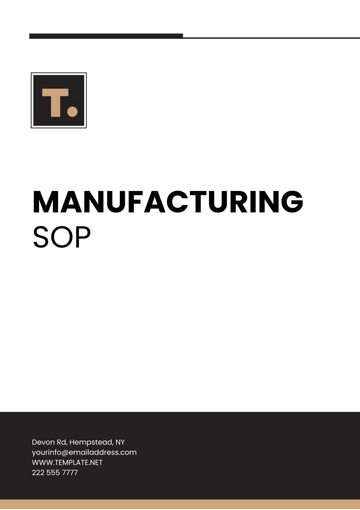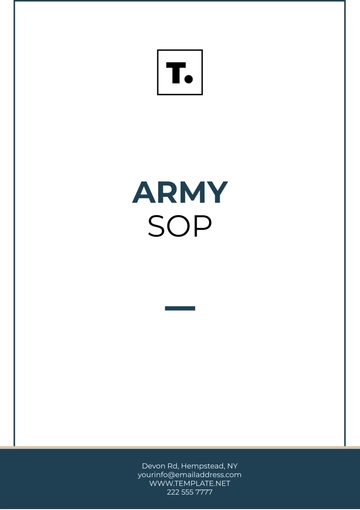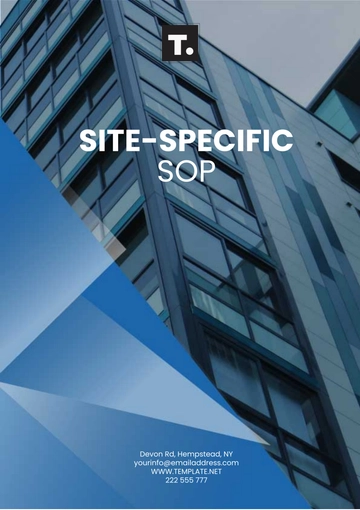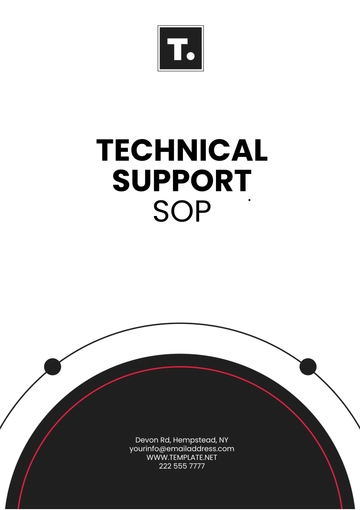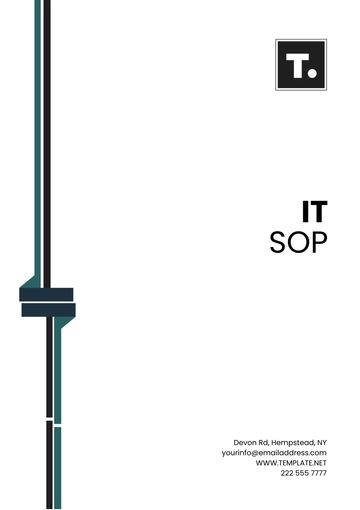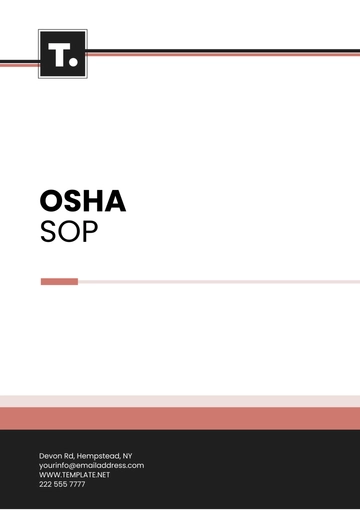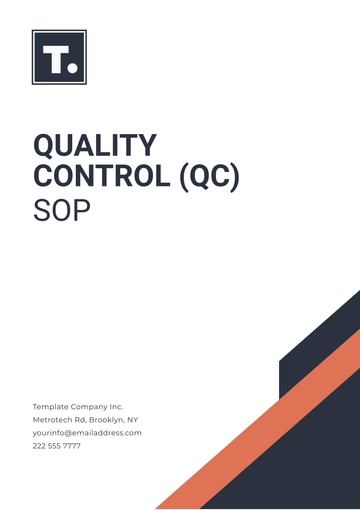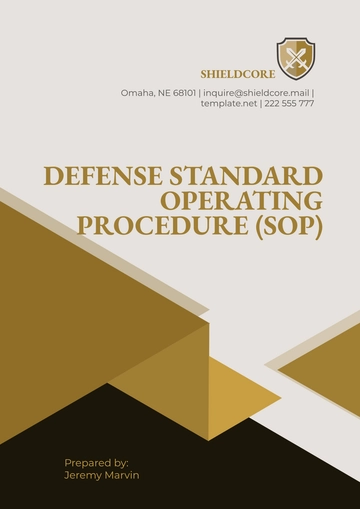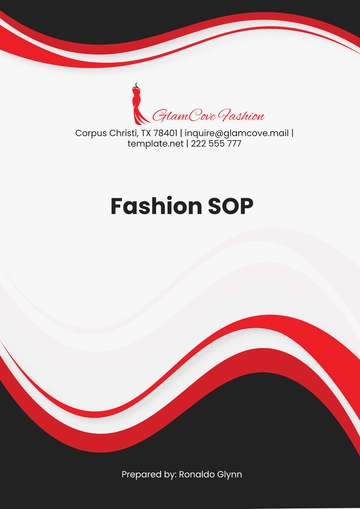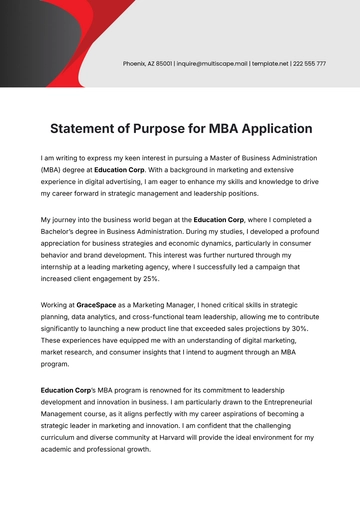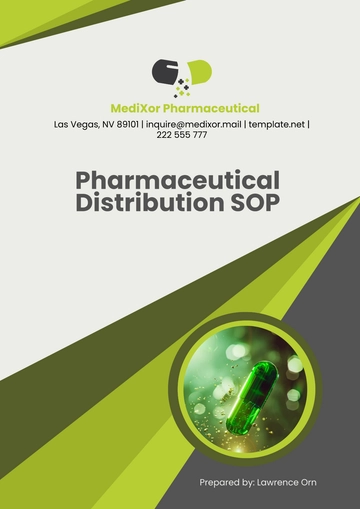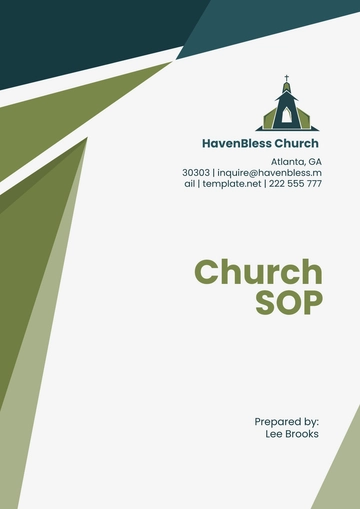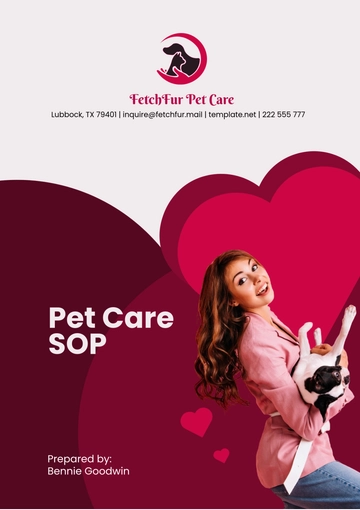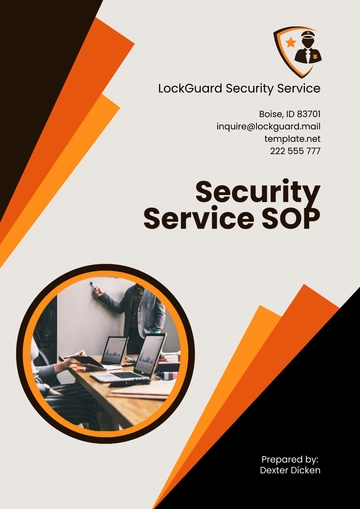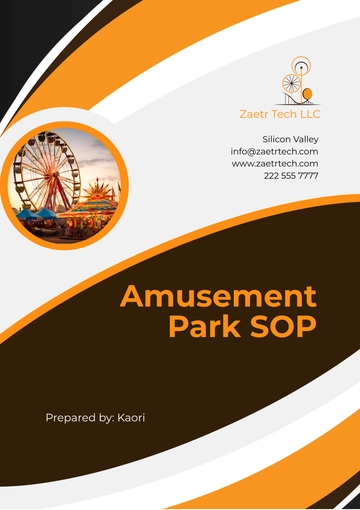Free Spa Safety SOP
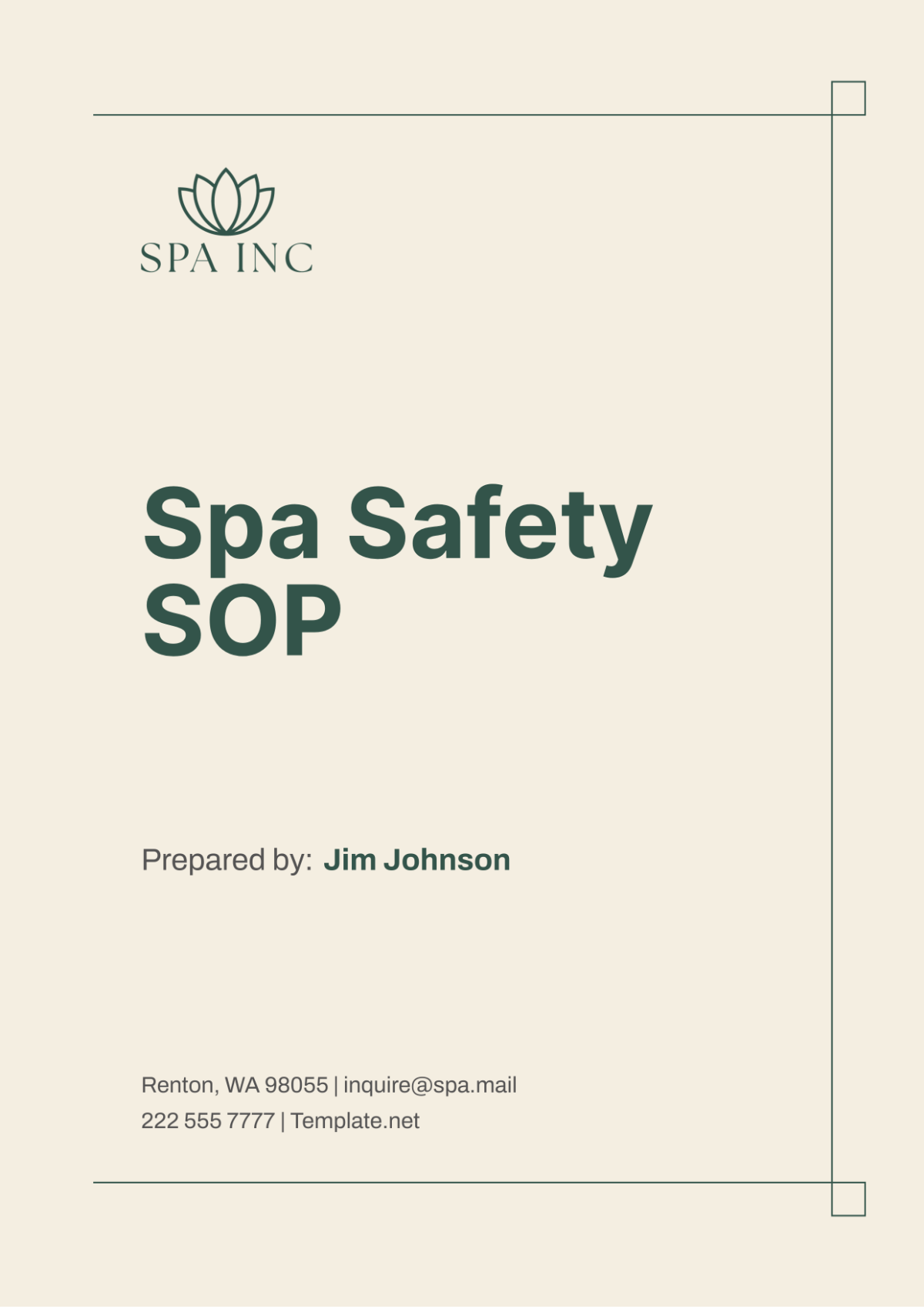
I. Introduction
A. Purpose
The purpose of this Standard Operating Procedure (SOP) is to establish guidelines and protocols to ensure the safety and well-being of both employees and guests at [Your Company Name] Spa. By implementing these procedures, we aim to minimize the risk of accidents, injuries, and exposure to hazardous materials, thereby fostering a secure and comfortable environment for all spa activities.
B. Scope
This SOP applies to all employees, contractors, and guests at [Your Company Name] Spa. It covers safety procedures related to general operations, facility management, specific treatments, and emergency situations. Every individual within the spa premises is expected to comply with these guidelines to maintain a high standard of safety and mitigate potential risks.
C. Definitions
PPE (Personal Protective Equipment): Equipment worn to minimize exposure to hazards that cause serious workplace injuries and illnesses. Examples include gloves, masks, goggles, and aprons.
MSDS (Material Safety Data Sheet): Document that provides information on the properties of hazardous chemicals and how they affect health and safety. MSDS sheets must be readily accessible to employees for all chemicals used in the spa.
Hydrotherapy: Treatment using water for pain relief and therapy. This includes techniques such as whirlpool baths, hot tubs, and hydro massage.
II. General Safety Procedures
A. Employee Responsibilities
1. Training and Certification
All spa employees must complete mandatory safety training and obtain necessary certifications before commencing work. Training includes first aid, CPR, fire safety, chemical handling, and specific training related to spa treatments. Regular refresher courses must be attended annually to ensure up-to-date knowledge and skills.
2. Personal Protective Equipment (PPE)
Employees are required to wear appropriate PPE depending on their job roles and the tasks they perform. For example:
Massage Therapists: Use clean, sanitized sheets and wear gloves if there are open wounds on their hands to prevent cross-contamination.
Estheticians: Wear gloves, masks, and eye protection when handling chemicals or performing treatments that involve skin penetration to minimize exposure to harmful substances.
Maintenance Staff: Use gloves, goggles, and aprons when handling cleaning agents or repairing equipment to protect against chemical splashes and injuries.
3. Health and Hygiene
Employees must adhere to strict personal hygiene standards to prevent the spread of infections and maintain a clean environment. This includes:
Regular hand washing before and after each treatment to prevent the spread of germs.
Proper disposal of waste and used materials in designated bins to maintain cleanliness and prevent contamination.
Following guidelines for proper uniform attire, including wearing closed-toe shoes and tied-back hair to prevent accidents and maintain a professional appearance.
B. Guest Safety
1. Welcome and Orientation
Upon arrival, guests receive a comprehensive safety briefing that includes:
Detailed explanation of the facility layout, including emergency exits, fire alarms, and first aid stations, to familiarize guests with their surroundings.
Information on available services and treatments, including an overview of potential risks and safety precautions.
Instructions on how to use lockers and store personal belongings safely to prevent theft and ensure a hassle-free experience.
2. Health and Medical Information
Guests are required to complete a thorough health questionnaire before undergoing any treatments. This information helps identify any potential risks or contraindications for specific treatments, ensuring the safety and well-being of the guest. Employees must review this information and consult with the guest regarding any concerns or medical conditions that may affect their treatment.
3. Safe Usage Guidelines
Guests must be informed about the correct usage of spa facilities to prevent accidents and injuries. This includes:
Setting maximum time limits for sauna and steam room usage to prevent overheating and dehydration.
Providing clear instructions for safe entry and exit procedures for pools, hot tubs, and hydrotherapy equipment to prevent slips, falls, and other accidents.
Emphasizing the importance of staying hydrated and reporting any discomfort immediately to spa staff to ensure prompt assistance and appropriate action.
III. Facility Safety
A. Equipment Safety
1. Regular Maintenance
All spa equipment must undergo regular maintenance checks to ensure optimal performance and safety. This includes:
Performing monthly inspections of massage tables, hydrotherapy tubs, skincare devices, and other equipment to identify and address any issues or malfunctions promptly.
Scheduling annual servicing of electrical equipment by a certified technician to detect and repair potential hazards and ensure compliance with safety standards.
Immediately addressing any faulty equipment by either repairing it or replacing it to prevent accidents, injuries, or disruptions to spa operations.
2. Safety Inspections
A designated safety officer will conduct weekly inspections to identify and address potential hazards throughout the spa premises. Inspection points include:
Checking for frayed wires, loose connections, or exposed electrical components that could pose a fire hazard or electrical shock risk.
Ensuring fire extinguishers are properly mounted, fully charged, and easily accessible in case of emergency, with clear signage indicating their locations.
Verifying that all safety signs, emergency instructions, and evacuation routes are visible, legible, and up-to-date to facilitate prompt and orderly responses to emergencies.
B. Chemical Safety
1. Storage and Handling
All chemicals used in the spa, such as cleaning agents and skincare products, must be stored in a secure, well-ventilated area away from heat, direct sunlight, and incompatible substances. Storage guidelines include:
Keeping chemicals in their original containers with labels intact to prevent misidentification or accidental exposure.
Storing flammable materials in designated flammable storage cabinets or areas away from ignition sources to minimize fire risks.
Ensuring that spill containment measures, such as spill kits and absorbent materials, are readily available and clearly labeled to facilitate prompt cleanup and minimize environmental impact in the event of a spill.
2. Usage Guidelines
Employees must follow strict guidelines for the safe handling and usage of chemicals to prevent accidents, injuries, and exposure to hazardous substances. Key guidelines include:
Using appropriate PPE, such as gloves, goggles, and masks, when handling chemicals to protect against skin contact, inhalation, and eye irritation.
Diluting concentrated chemicals according to manufacturer instructions to prevent overexposure and minimize risks of skin irritation or chemical burns.
Avoiding mixing different chemicals, unless specifically instructed by the manufacturer, to prevent chemical reactions that could produce toxic fumes, explosions, or other hazards.
3. Emergency Procedures
In the event of a chemical spill or exposure, employees must follow established emergency procedures to minimize risks and ensure the safety of everyone in the spa. Procedures include:
Evacuating the affected area immediately and notifying the supervisor or designated safety officer.
Using spill containment kits and appropriate PPE to contain and clean up the spill, following established spill response protocols and disposal guidelines.
Seeking medical attention for anyone exposed to hazardous chemicals and providing first aid as necessary, including rinsing affected areas with water and removing contaminated clothing.
C. Environmental Controls
1. Temperature and Humidity
Maintaining appropriate temperature and humidity levels is essential for ensuring guest comfort, preventing mold growth, and minimizing risks associated with extreme temperatures. Guidelines include:
Keeping treatment rooms at a comfortable temperature range of 70-75°F to ensure optimal relaxation and comfort for guests during treatments.
Monitoring humidity levels to maintain a relative humidity of 40-60%, which helps prevent mold growth and maintains a pleasant indoor environment.
Ensuring that hot tubs and saunas do not exceed safe temperature limits (104°F for hot tubs, 195°F for saunas) to prevent burns, overheating, and dehydration among guests.
2. Ventilation
Proper ventilation is crucial for maintaining indoor air quality, removing airborne contaminants, and ensuring a healthy and comfortable spa environment. Measures include:
Regularly checking and cleaning HVAC systems, including filters, vents, and ducts, to ensure efficient airflow and remove dust, allergens, and other pollutants.
Ensuring that ventilation systems in treatment rooms, chemical storage areas, and other enclosed spaces are functioning properly to remove odors, fumes, and excess moisture.
Using exhaust fans and ventilation hoods in areas where chemicals are stored or used to capture and remove airborne contaminants, such as chemical vapors or fumes, to prevent respiratory irritation and exposure.
IV. Emergency Procedures
A. First Aid
1. First Aid Kits
First aid kits must be readily available at multiple locations within the spa, including the reception area, treatment rooms, and staff areas, to ensure prompt access in case of injury or medical emergency. Kits should be stocked with:
Bandages, gauze, and adhesive tape for wound care and dressing.
Antiseptic wipes and ointments for cleaning and disinfecting minor wounds.
CPR masks and disposable gloves for providing cardiopulmonary resuscitation (CPR) and preventing cross-contamination.
A list of emergency contact numbers, including local emergency services, poison control, and the nearest medical facility, for quick reference during emergencies.
2. Trained Personnel
At least two employees per shift must be trained in first aid and CPR to provide immediate assistance in case of medical emergencies. Training should cover basic first aid techniques, CPR, AED (automated external defibrillator) use, and emergency response protocols. Certification should be renewed every two years, and records of certified personnel should be maintained for documentation and compliance purposes.
B. Fire Safety
1. Fire Extinguishers
Fire extinguishers must be strategically placed throughout the spa, particularly in high-risk areas such as kitchens, laundry rooms, and chemical storage areas, to ensure quick access in case of fire. Employees should be trained in the proper use of fire extinguishers and familiarize themselves with the PASS technique (Pull, Aim, Squeeze, Sweep) for effective fire suppression. Inspections should be conducted monthly to ensure fire extinguishers are fully charged, in good working condition, and compliant with local fire safety regulations.
2. Evacuation Routes
Clear and visible evacuation maps should be posted in each room, indicating primary and secondary evacuation routes, assembly points, and locations of fire extinguishers and emergency exits. Regular fire drills must be conducted quarterly to ensure all employees and guests are familiar with evacuation procedures and can evacuate the building safely and efficiently in case of fire or other emergencies. During an evacuation, employees must assist guests to the nearest exit and regroup at the designated assembly point outside the building to ensure accountability and safety.
C. Incident Reporting
1. Documentation
All incidents, regardless of severity, must be documented using an incident report form to record essential details and facilitate investigation and follow-up actions. Details to be recorded include:
Date, time, and location of the incident to establish a timeline and context for the event.
Names and contact information of individuals involved, including employees, guests, and witnesses.
Description of the incident, including what happened, how it occurred, and any contributing factors or hazards.
Actions taken in response to the incident, including first aid administered, emergency services contacted, and steps taken to mitigate risks or prevent recurrence.
2. Follow-up Actions
After an incident, a thorough investigation should be conducted to identify the root cause and implement corrective actions to prevent recurrence. Follow-up actions may include:
Reviewing incident reports and conducting interviews to gather additional information and identify contributing factors or systemic issues.
Updating safety procedures, protocols, or training materials based on lessons learned from the incident to improve prevention and response efforts.
Communicating with affected individuals, including employees and guests, to address concerns, provide support, and ensure transparency throughout the process.
V. Specific Treatment Safety
A. Massage Therapy
1. Techniques and Limits
Massage therapists must adhere to industry-standard techniques and best practices to ensure safe and effective treatments for clients. This includes:
Using appropriate pressure based on client feedback and individual preferences to avoid causing discomfort or injury.
Avoiding high-risk areas, such as the spine and major joints, without proper training and certification to minimize the risk of injury or aggravating existing conditions.
Communicating openly with clients to ensure their comfort and well-being throughout the treatment and adjusting techniques as needed to accommodate their needs and preferences.
2. Client Screening
Clients must complete a pre-treatment screening form to provide relevant medical history, identify any contraindications or risk factors, and ensure the safety and suitability of the treatment. Therapists should review the form with clients, clarify any concerns or questions, and modify treatments as necessary to accommodate medical conditions or contraindications, ensuring a safe and beneficial experience for the client.
B. Hydrotherapy
1. Equipment Safety
Hydrotherapy equipment, such as whirlpool baths, hydro massage tables, and Vichy showers, must be properly maintained and sanitized to ensure safety and hygiene. This includes:
Performing daily cleaning and disinfection of equipment surfaces, including tubs, jets, and nozzles, to remove bacteria, algae, and other contaminants.
Conducting weekly checks for mechanical issues, such as leaks, malfunctions, or loose fittings, to prevent accidents or injuries during use.
Implementing monthly water quality testing and treatment protocols to maintain optimal water chemistry and hygiene standards, including pH balance, chlorine levels, and bacterial control measures.
2. Client Safety
Clients must be educated about the safe use of hydrotherapy equipment , including:
Providing clear instructions and demonstrations on how to safely enter and exit hydrotherapy equipment, such as whirlpool baths or hydro massage tables, to prevent slips, falls, or injuries.
Setting and enforcing time limits for hydrotherapy sessions to prevent overexposure to water or heat, dehydration, and other risks associated with prolonged use.
Monitoring clients during hydrotherapy sessions for signs of discomfort, overheating, or distress, and providing assistance or adjusting treatment as needed to ensure their safety and well-being.
C. Skincare Treatments
1. Product Safety
All skincare products used in treatments must meet stringent safety standards and undergo thorough testing to ensure efficacy and minimize risks of adverse reactions or side effects. Guidelines include:
Sourcing products from reputable suppliers and manufacturers with established quality control processes and adherence to regulatory standards.
Checking product labels for ingredients, expiration dates, and usage instructions to ensure safe and appropriate use during treatments.
Conducting patch tests or skin sensitivity assessments for new clients or products to identify potential allergies or sensitivities and minimize risks of adverse reactions or skin irritation.
2. Allergy Management
Clients must disclose any known allergies, sensitivities, or medical conditions on their intake forms to ensure safe and appropriate treatment. Employees should review this information before each treatment session and take necessary precautions to minimize risks, including:
Selecting products and ingredients that are hypoallergenic, fragrance-free, and suitable for sensitive skin, whenever possible.
Performing patch tests or spot treatments on a small area of skin to assess individual tolerance and sensitivity before proceeding with full treatments.
Providing alternative products or treatment options for clients with specific allergies or sensitivities to ensure their comfort and safety during spa services.
VI. Regular Review and Training
A. Scheduled Reviews
Safety procedures and protocols must undergo regular reviews and updates to ensure they remain current, effective, and compliant with industry standards and regulations. This involves:
Assessing recent incident reports, near misses, and safety audits to identify trends, recurring issues, or areas for improvement.
Consulting with employees, supervisors, and safety committees to gather feedback, insights, and suggestions for enhancing safety practices and procedures.
Updating SOPs, training materials, and emergency response plans based on lessons learned, new information, or changes in regulations to ensure accuracy, relevance, and alignment with organizational goals and priorities.
B. Training Programs
Ongoing training and development programs must be established to ensure employees are equipped with the knowledge, skills, and competencies needed to perform their jobs safely and effectively. This includes:
Conducting monthly safety meetings or toolbox talks to review safety procedures, discuss recent incidents or near misses, and reinforce key safety messages and behaviors.
Providing annual certification courses and refresher training for first aid, CPR, fire safety, chemical handling, and other critical safety topics to maintain compliance and competency.
Offering specialized training sessions or workshops for new equipment, technologies, or procedures to ensure employees are prepared to handle new challenges and opportunities in the spa environment.
VII. Conclusion
A. Commitment to Safety
[Your Company Name] Spa is committed to maintaining the highest safety standards to protect our employees and guests. By implementing comprehensive safety procedures, providing ongoing training and support, and fostering a culture of safety awareness and accountability, we strive to create a safe, healthy, and enjoyable environment for everyone.
B. Continuous Improvement
Safety is an ongoing process, and [Your Company Name] Spa is dedicated to continuous improvement. We recognize that there is always room for improvement, and we actively seek feedback, evaluate performance, and implement best practices to enhance our safety programs, procedures, and outcomes. Through collaboration, communication, and a shared commitment to excellence, we will continue to raise the bar for safety and quality in the spa industry.
- 100% Customizable, free editor
- Access 1 Million+ Templates, photo’s & graphics
- Download or share as a template
- Click and replace photos, graphics, text, backgrounds
- Resize, crop, AI write & more
- Access advanced editor
Establish standardized safety procedures with the Spa Safety SOP Template from Template.net. This editable and customizable document outlines standard operating procedures (SOPs) for ensuring safety in spa operations. Crafted for clarity and effectiveness, it's editable in our AI Editor Tool, ensuring consistency and adherence to safety protocols across your spa facilities.




